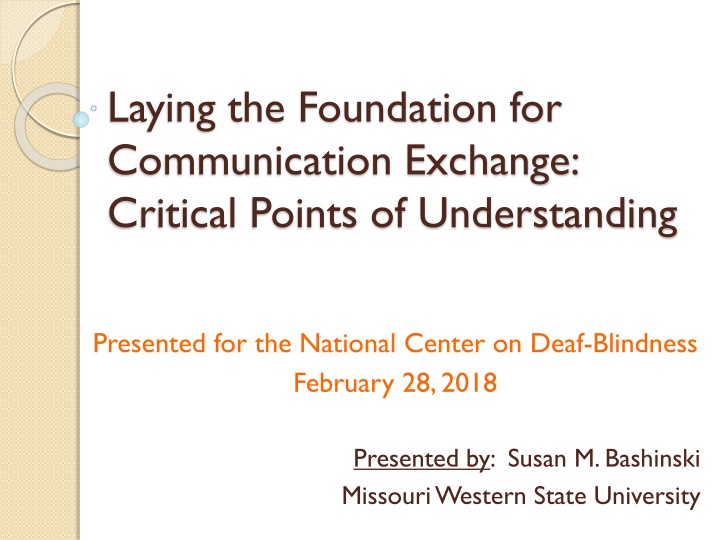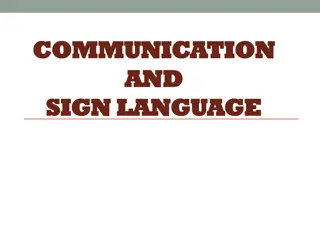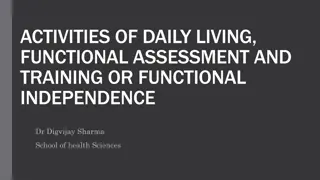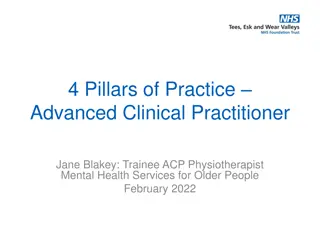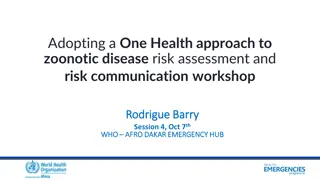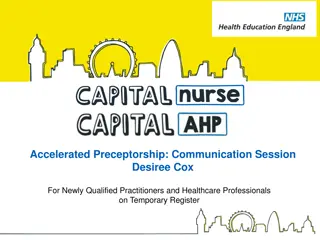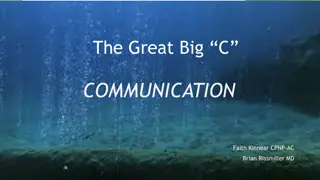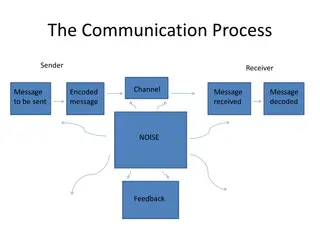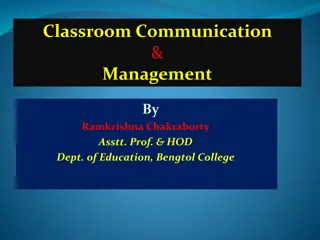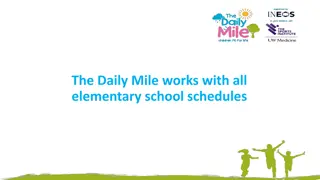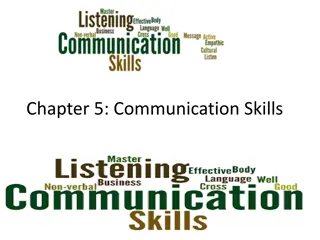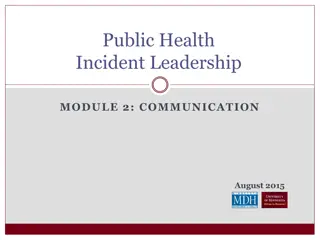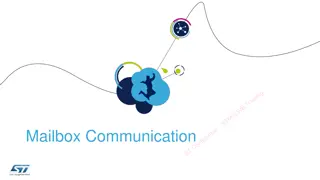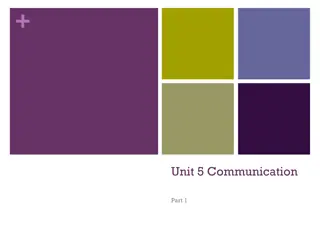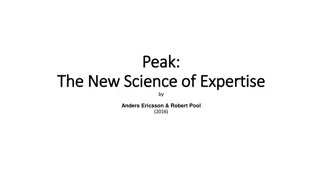Building Effective Communication in Daily Practice
Enhance communication skills through key reminders, contrast non-symbolic and symbolic communication, and create secure routines. Understand the importance of communication rights and the impact of assumptions on learners. Discover practical insights to improve communication interactions.
Download Presentation

Please find below an Image/Link to download the presentation.
The content on the website is provided AS IS for your information and personal use only. It may not be sold, licensed, or shared on other websites without obtaining consent from the author.If you encounter any issues during the download, it is possible that the publisher has removed the file from their server.
You are allowed to download the files provided on this website for personal or commercial use, subject to the condition that they are used lawfully. All files are the property of their respective owners.
The content on the website is provided AS IS for your information and personal use only. It may not be sold, licensed, or shared on other websites without obtaining consent from the author.
E N D
Presentation Transcript
Laying the Foundation for Communication Exchange: Critical Points of Understanding Presented for the National Center on Deaf-Blindness February 28, 2018 Presented by: Susan M. Bashinski Missouri Western State University
OBJECTIVES Following this webinar, participants will be able to: 1. Explain at least one way in which 3 or 4 of the key Communication Reminders discussed in the webinar may be applied in their own daily lives / practice. 2. Contrast the basic differences between (a) nonsymbolic and symbolic and (b) non- intentional and intentional communication. 3. Describe the aspects of a routine, which can make a critical contribution to a learner s feeling sufficiently safe and secure to reach out to those around her in a communicative manner.
ASSUMPTIONS There is absolutely NO learner who does not communicate. Not having a voice to say I d had enough food or the bath water was too hot or to tell someone I loved them was the thing that made me feel most inhuman. Words and speech...give us free will.... Without a voice, I couldn t control even the simplest things. (p. 79) Pistorius, M. (2013). Ghost boy: The miraculous escape of a misdiagnosed boy trapped inside his own body. Nashville, TN: Nelson Books.
NOT BEING ABLE TO SPEAK IS NOT THE SAME AS NOT HAVING ANYTHING TO SAY
NJC: Communication Bill of Rights For more information, go to the NJC website at: www.asha.org/njc Brady, N. C., Bruce, S., Goldman, A., Erickson, K., Mineo, B., Ogletree, B., Wilkinson, K. (2016). Communication services and supports for individuals with severe disabilities: Guidance for assessment and intervention. American Journal on Intellectual and Developmental Disabilities, 121(2), 121-138.
COMMUNICATION REMINDERS
Everyone communicates! (Language is just one means.) Partners need to EXPECT each learner to communicate.
Observe and focus! Be in the moment and ATTUNED to the learner.
Behavior IS communication! (Begin to ORGANIZE a way for a learner s behaviors to become communicative.)
Communication is both a skill and a sensorimotor experience.
Early expression of memories will likely incorporate the movement and tactile aspects of the experience the learner is recalling.
Labels commonly used may be very confusing.
For a learner who experiences deaf-blindness, the way in which she receives info. might be different from the way she expresses info.
Proper positioning and supports are essential to communication facilitation.
Maximize the learners sensory access.
Teach multiple modes of communication! (A GoTalk won t work in the pool or bathtub, and batteries in AAC devices, hearing aids, and cochlear implants go dead )
WAIT! ( Patience is a virtue. )
Body language is a two-way street.
Model use of a learners communication modes.
Communication is the foundation for literacy skills.
Today affects tomorrow, but doesn t predict it!
INTRODUCTION: BUILDING A FOUNDATION FOR COMMUNICATION EXCHANGE
NONSYMBOLIC COMMUNICATION DEVELOPMENT Learners demonstrate skills at multiple points along the continuums used to describe communication development Learners demonstrate different skills with familiar and unfamiliar partners Learners demonstrate skills different skills in familiar and unfamiliar environments
SEQUENCE OF NONSYMBOLIC COMMUNICATION DEVELOPMENT Levels of communication development are not differentiated by distinct boundaries A shift from one level (i.e., stage) of communication does not occur overnight Learners communication levels are generally labeled by the descriptor that corresponds with the majority of their communication skills
DEVELOPMENT OF SYMBOLIZATION ABILITY
SYMBOLIZATION Definition of SYMBOL : one thing that stands for (i.e., represents ) another Referent (object / action to be represented) Representation Symbolic communication - using ABSTRACT representations with DISTANCING
LEVELS OF SYMBOLIZATION DEVELOPMENT Different authors / researchers identify varying numbers of stages of the development of symbolization ability. We shall discuss these primary stages: Nonsymbolic Concrete symbolic (Transitional) Abstract symbolic
SYMBOLIZATION: TYPES Prelinguistic Nonlinguistic Presymbolic Nonsymbolic* (* *preferred by Bashinski, because pre- indicates linguistic / symbolic development will definitely follow )
LEVELS OF SYMBOLIZATION DEVELOPMENT: NONSYMBOLIC Idiosyncratic signals Responsibility for successful communication rests with the partner Context of interaction is critical Examples of nonsymbolic forms: Crying, body posturing, acting on people or objects, using unconventional gestures, vocalizing
COMMUNICATION BEGINS WITH NONSYMBOLIC BEHAVIOR Observe a learner during unstructured time Follow the learner s lead Embellish potential communicative signals OFTEN .. Nonsymbolic skills must be directly taught
LEVELS OF SYMBOLIZATION DEVELOPMENT: TRANSITIONAL Expressive signals become more conventional Magnitude of partner s role diminishes Importance of context begins to diminish Concrete symbolic communication (e.g., 3-D objects, tangible symbols) Examples of transitional forms: gestures, use of object representations and photographs
LEVELS OF SYMBOLIZATION DEVELOPMENT: SYMBOLIC Conventional expressions, consistent with learner s culture and with consideration of primary language Magnitude of partner s role continues to diminish Communication can occur free of context Examples of symbolic forms: speech, braille, print, manual sign language, written words
SYMBOLIZATION: COMPARISON NONSYMBOLIC TRANSITIONAL (Concrete Symbolic) SYMBOLIC (Abstract Symbolic) Birth 8 / 9 mos. 8 / 9 12 / 15 mos. 12 / 15 mos. Idiosyncratic gestures /vocalizations Conventional gestures / vocalizations Conventional verbalizations Context is critical to derivation of meaning Concretely-linked referents Abstract referents May demonstrate little overt behavior 3-dimensional representations (i.e., objects) 2-dimensional representations (i.e., traditional orthography) Learner is responsible for own communication Responsibility for communicative interaction rests with partner Partner shares responsibility for communicative interaction
DEVELOPMENT OF INTENTIONALITY
INTENTIONALITY Definition of COMMUNICATIVE INTENTIONALITY : Deliberate pursuit of a goal, as well as the means to obtain the goal Intentional behavior vs. Intentional communication (to have impact on another person, not just objects)
SEQUENCE OF COMMUNICATIVE INTENTIONALITY DEVELOPMENT Though different authors / researchers identify varying numbers of stages of communication development, for our purposes today, we shall identify these primary stages: Non-intentional Transitional Behavior is intentional, but is NOT intentionally communicative Intentional (behavior is BOTH intentional and intentionally communicative) Concrete symbolic / Transitional Abstract symbolic
INTENTIONALITY: TYPES Preintentional Nonintentional (preferred by Bashinski, because pre- indicates intentional development will definitely follow )
STAGES of INTENTIONALITY: NONINTENTIONAL In this stage, the learner is neither deliberately pursuing a goal nor aware of a means to obtain the goal. A communication partner interprets the learner s behaviors as if these were intentional.
LEVELS OF INTENTIONALITY DEVELOPMENT: NONINTENTIONAL Expressive: Idiosyncratic; behavior state Context-driven Child learns the power of communication Partner must interpret behaviors Receptive: Comprehends speaker s tone of voice and physical contact / touch
STAGES of INTENTIONALITY: TRANSITIONAL INTENTIONALITY In this stage, the learner is deliberately engaging in behavior, but not with a mental plan for obtaining a desired goal. A communication partner may use context to derive meaning of the learner s behavior (some interpretation, of unconventional FORMS, might be required).
LEVELS OF INTENTIONALITY DEVELOPMENT: TRANSITIONAL INTENTIONALITY Expressive: Dawning of intentionality Purposeful communication begins to emerge Context contributes to a minor degree Receptive: Comprehension of some words and simple directives, in context
STAGES of INTENTIONALITY: INTENTIONAL In this stage, the learner is deliberately pursuing a goal and has a mental plan (i.e., a means ) for obtaining the desired goal and / or is deliberately engaging in an exchange with another person for some intended purpose. [NOTE: The form of the learner s communication might still be unconventional.] A learner uses his behaviors for the purpose of affecting another person.
LEVELS OF INTENTIONALITY DEVELOPMENT INTENTIONAL Expressive: Beginning of true symbolic express. Use of first true words Communication becomes independent of context Receptive: Comprehension of words; comprehension exceeds production
ESSENTIAL TAKE-AWAYS 1. Meet each learner where she is; begin to build a communication system from that point. 2. Consistently respond to each learner s behavior in a predictable way. 3. Plan programming to help the learner grow in the direction of conventional and intentional, symbolic communication.
THANK YOU! Susan M. Bashinski 816.271.5629 sbashinski@missouriwestern.edu
